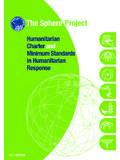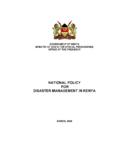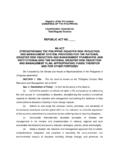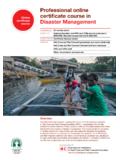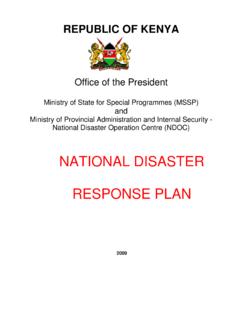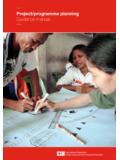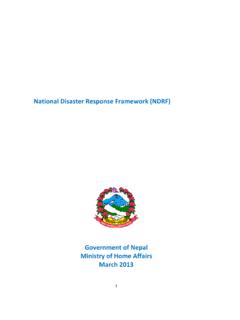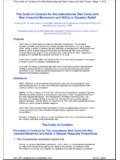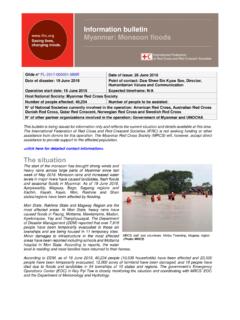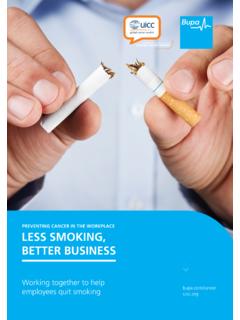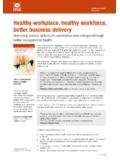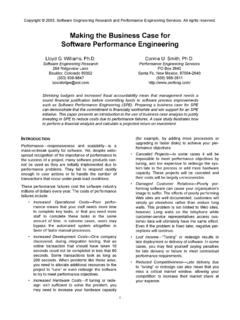Transcription of World Disasters Report 2016 The International …
1 World Disasters Report 2016 Resilience: saving lives today, investing for tomorrowThis year s World Disasters Report focuses on resilience within humanitarian action. The Report explores the different meanings of resilience, as well as criticisms, and its application both before and after crises. It considers how resilience is measured, and the importance of building evidence. The Report examines the business case for adopting a resilience approach, arguing that investing in resilience yields financial and social benefits, as well as saving lives. It looks at anticipation, and some of the tools and approaches that exist. The Report explores the importance of mental health and psychosocial support for those affected by crises, and makes the case that more effort is needed in this often-underestimated area.
2 It reviews the nature of partnership between key actors, and argues that more attention is needed in building more equitable relationships based on trust and transparency. Finally, the Report considers the future role of a resilience approach in the face of threats including climate change, conflict and World Disasters Report 2016 features: making the case for resilience proving the case: measurement and evidence time to act: investing in resilience anticipation: getting better at getting ready inner resilience: mental health and psychosocial support stronger together: partnerships that build resilience resilience in the future: 2025 and beyond disaster data. More vulnerable people live more exposed to more extreme weather. Tens of millions have been displaced by Disasters in recent years.
3 There is no greater challenge for this generation and the next than to prevent and prepare for the brutal force of climate variability and change. It is also a question of justice: the poor who did nothing to produce climate change are first and hardest hit. We, the rich and robust, who caused climate change are last and least hit. This IFRC World Disasters Report describes the monumental challenges at hand, but also what is needed to meet Egeland, Secretary-General, Norwegian Refugee lives, changing Disasters Report 20162016 Published annually since 1993, the World Disasters Report brings together the latest trends, facts and analysis of contemporary crises and International Federation of Red Cross and Red Crescent Societies would like to express its gratitude to the following donors for committing to and supporting this publication: World Disasters ReportResilience.
4 Saving lives today, investing for tomorrowISBN 978-92-9139-240-7 The Fundamental Principles of the International Red Cross and Red Crescent MovementHumanity The International Red Cross and Red Crescent Movement, born of a desire to bring assis-tance without discrimination to the wounded on the battlefield, endeavours, in its International and national capacity, to prevent and alleviate human suffering wherever it may be found. Its purpose is to protect life and health and to ensure respect for the human being. It promotes mutual under-standing, friendship, cooperation and lasting peace among all It makes no discrimination as to na-tionality, race, religious beliefs, class or political opinions. It endeavours to relieve the suffering of individuals, being guided solely by their needs, and to give priority to the most urgent cases of In order to continue to enjoy the confi-dence of all, the Movement may not take sides in hostilities or engage at any time in controversies of a political, racial, religious or ideological The Movement is independent.
5 The National Societies, while auxiliaries in the human-itarian services of their governments and subject to the laws of their respective countries, must al-ways maintain their autonomy so that they may be able at all times to act in accordance with the principles of the service It is a voluntary relief move-ment not prompted in any manner by desire for There can be only one Red Cross or Red Cres-cent Society in any one country. It must be open to all. It must carry on its humanitarian work throughout its The International Red Cross and Red Crescent Movement, in which all societies have equal status and share equal responsibilities and duties in helping each other, is worldwide. The International Federation of Red Cross and Red Crescent Societies (IFRC) is the World s largest volunteer-based humanitarian network.
6 With our 190 member National Red Cross and Red Crescent Societies worldwide, we are in virtually every community reaching million people annually through long-term services and development programmes, as well as 110 million people through disaster response and early recovery programmes. We act before, during and after Disasters and health emergencies to meet the needs and improve the lives of vulnerable people. We do so with impartiality as to nationality, race, gender, religious beliefs, class and political by Strategy 2020 our collective plan of action to tackle the major humanitarian and development challenges of this decade we are committed to saving lives and changing strength lies in our volunteer network, our communitybased expertise and our independence and neutrality. We work to improve humanitarian standards, as partners in development, and in response to Disasters .
7 We persuade decision-makers to act at all times in the interests of vulnerable people. The result: we enable healthy and safe communities, reduce vulnerabilities, strengthen resilience and foster a culture of peace around the photo: Rwanda, Gisagara District. 5 April, 2016. Rwanda Red Cross food security programme. Rural residents tend to a community garden. Distribution of seeds along with training on crop management are aimed at improving resilience to food insecurity in vulnerable areas. Juozas Cernius/IFRCE nabling action 1 Build strong National Red Cross Red Crescent SocietiesEnabling action 3 Function effectively as the International FederationEnabling action 2 Pursue humanitarian diplomacy to prevent and reduce vulnerability in a globalized worldStrategic aim 1 Save lives, protect livelihoods, and strengthen recovery from Disasters and crisesStrategic aim 3 Promote social inclusion and a culture of non-violence and peaceStrategic aim 2 Enable healthy and safe livingSTRATEGY 2020 Saving lives, changing Disasters Report 2016 Resilience: saving lives today, investing for tomorrowThis year s World Disasters Report focuses on resilience within humanitarian action.
8 The Report explores the different meanings of resilience, as well as criticisms, and its application both before and after crises. It considers how resilience is measured, and the importance of building evidence. The Report examines the business case for adopting a resilience approach, arguing that investing in resilience yields financial and social benefits, as well as saving lives. It looks at anticipation, and some of the tools and approaches that exist. The Report explores the importance of mental health and psychosocial support for those affected by crises, and makes the case that more effort is needed in this often-underestimated area. It reviews the nature of partnership between key actors, and argues that more attention is needed in building more equitable relationships based on trust and transparency.
9 Finally, the Report considers the future role of a resilience approach in the face of threats including climate change, conflict and World Disasters Report 2016 features: making the case for resilience proving the case: measurement and evidence time to act: investing in resilience anticipation: getting better at getting ready inner resilience: mental health and psychosocial support stronger together: partnerships that build resilience resilience in the future: 2025 and beyond disaster data. More vulnerable people live more exposed to more extreme weather. Tens of millions have been displaced by Disasters in recent years. There is no greater challenge for this generation and the next than to prevent and prepare for the brutal force of climate variability and change. It is also a question of justice: the poor who did nothing to produce climate change are first and hardest hit.
10 We, the rich and robust, who caused climate change are last and least hit. This IFRC World Disasters Report describes the monumental challenges at hand, but also what is needed to meet Egeland, Secretary-General, Norwegian Refugee lives, changing Disasters Report 20162016 Published annually since 1993, the World Disasters Report brings together the latest trends, facts and analysis of contemporary crises and International Federation of Red Cross and Red Crescent Societies would like to express its gratitude to the following donors for committing to and supporting this publication: World Disasters ReportResilience: saving lives today, investing for tomorrowISBN 978-92-9139-240-7 Swedish International Development Cooperation AgencyThe Fundamental Principles of the International Red Cross and Red Crescent MovementHumanity The International Red Cross and Red Crescent Movement, born of a desire to bring assis-tance without discrimination to the wounded on the battlefield, endeavours, in its International and national capacity, to prevent and alleviate human suffering wherever it may be found.
